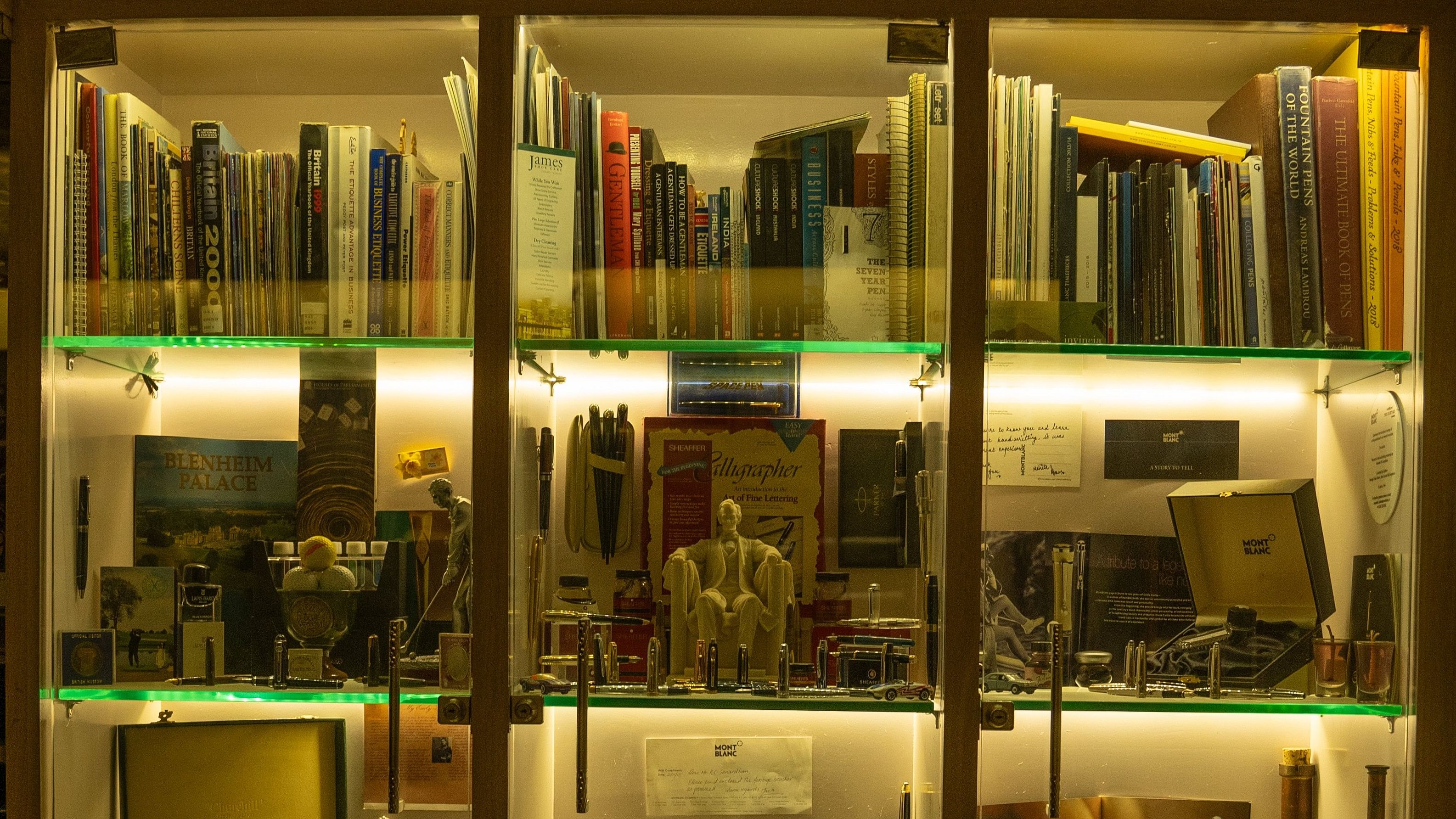
Glass displays with several pens, books, and artefacts can be found here.
Credit: DH photo
Tucked away on Fort D Street near K R Market area is a museum dedicated to handwriting and calligraphy.
Called J’s La Quill Museum, it was founded in 2016 by master calligraphist K C Janardhan. Before the pandemic broke out, it had three staffers. Now, he runs the space by himself, dusting and cleaning the displays even as he keeps an eye out for more items.
Registered under J’s La Quill Museum Charitable Trust, it is part of Janardhan’s ancestral house. On the first floor, you see a display of about 30 ink pens from a brand called Click, ranging in price from Rs 300 to Rs 3,500.
Rare tomes
Narrow steps lead to the museum on the second floor, which features books on calligraphy, nibs, quills and pens. Gentle music plays as you admire the calligraphy instruments.
“Initially people were writing with quills. We have around five original-cut quills and five sleeve and nib ones, boxes of 14 different varieties of nibs from varied companies given to us by Lindner & Co (that existed in the Chickpet area),” he says. More than 3,000 nibs and 4,000 fountain pens are showcased at the museum.
Fountain pens from brands like Montblanc, Lamy, Pelikan, Georg Jensen, and Faber Castelle from Germany; Cross, Sheaffer, Parker and Monteverde from USA; Waterman and Pierre Cardin from France; Pilot and Sailor from Japan; Omas, Aurora, and Visconti from Italy; and pencils from Staedtler and Rotring are on display here.
Replicas of popular brands like Montblanc, Parker, Namiki, Pilot, and Lamy, made by Chinese brands like Jinhao and Luoshi, and glass pens are also displayed. Indian brands like Click and Gama, inks from Sulekha (Swadhin, Swadeshi, and Firingi Kali), notepads, and erasers from all over the world are other interesting exhibits.
Typewriters
Placed opposite the entrance are four typewriters — Olivetti, Brother, Consul, and Jaykay. Glass paperweights, a copy of the Magna Carta that Janardhan picked up from Windsor Castle, gold gilding and burnishing instruments, inkwells made of crystal, glass and ‘panchaloha’ are among his prized possessions.
“Some of the books displayed here are either out of print or can cost up to
Rs 1 lakh,” Janardhan explains.
Pens are classified by region and theme. For example, Sheaffer pens are placed alongside a statue of Abraham Lincoln, vintage Parker pens are displayed alongside a Lapis Bard ink bottle, brushes depict the Eastern world, and a Sheaffer tribute to Ferrari is displayed next to a 1:18 replica of a car Michael Schumacher drove.
Return of writing
While many say that the advent of digital has eliminated writing, new premium phones come with styluses, Janardhan says. “The act of writing is still important. We might have evolved from writing on walls with stone to using quills on paper to writing with environmentally dangerous ball pens and gel pens. But fountain pens are classic instruments that are used even now,” he adds.
There is a huge market for fountain pens, including a considerable interest among IT professionals for nibs and nib holders, Janardhan says.
“Thanks to the Internet, one doesn’t have to go to different locations searching for one’s favourite pens now,” he says.
Museum visiting hours are 10 am to 5 pm. To visit, call 98451 86482.
How he gets artefacts
Pens and writing instruments are often sent as contributions to the museum.
“Friends from all over India, Europe, the US, and the UK send pens to me. In the future, the museum will be a ‘house of emotions’, where stories connected to each pen will be documented and shared,” Janardhan says.
The Pen Museum in Birmingham and the Contemporary Museum of Calligraphy, Moscow, are already well known, Janardhan says. His thought was that such spaces represent a niche and don’t bring everything together.
Janardhan hopes that in a decade the museum will expand. “I will work towards getting a Unesco Heritage Site status for the museum and the surrounding locality,” he says.